
Feature Article
Raw Oysters and Norovirus
The Centre for Food Safety (CFS) has been committed to promoting public awareness of the inherent risks of eating raw oysters. Nevertheless, food poisoning incidents associated with the consumption of raw oysters still occur in Hong Kong from time to time, many of which are caused by norovirus infection.
Like other bivalves, oysters feed themselves by filtering large amounts of water through their gills. Oysters growing in contaminated waters are more susceptible to contamination. Norovirus binds to oyster tissues within the gut. The concentration rate could be up to 99 times compared to the surrounding water. It is difficult to remove norovirus from oysters through cleansing. Depuration is also likely to be ineffective. The consumption of raw or undercooked bivalves therefore poses a higher risk of infection.
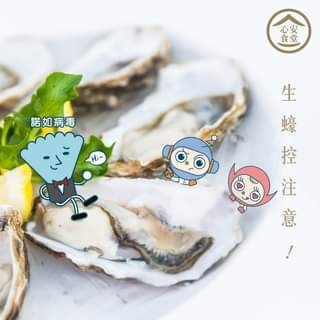
Norovirus — “Winter Vomiting Disease”
Norovirus is an important cause of foodborne infection throughout the world. The virus is mainly transmitted through contaminated food or water. It can also spread directly from person to person or indirectly via contaminated objects or aerosols. As few as ten viral particles are sufficient to cause illnesses. While alcohol-based antibacterial hand gels kill various pathogenic bacteria, they do not provide protection against norovirus.
Viral particles are excreted at high levels by infected people. Some infected individuals can be prolonged shedders. The viral particles can stick to objects and cause infection after days or weeks. Thorough handwashing is thus very important in preventing the spread of norovirus. The incubation period of norovirus infection is usually 24 to 48 hours. The predominant symptoms are vomiting, watery diarrhoea and nausea, while low fever may sometimes occur. Norovirus illnesses can be serious, especially for young children, the elderly and people with weakened immune systems. No vaccine or specific treatment is currently available for preventing or curing norovirus infection.
Norovirus can survive freezing temperatures. In comparison with most bacteria, it is relatively heat resistant and may remain infectious in food heated to 60°C for 30 minutes. The virus is acid-resistant, too. Eating contaminated oysters dressed with lemon juice, vinegar or alcohol does not help prevent norovirus infection.
Key Points to Note
- Norovirus infection is more common in winter and can cause large-scale food poisoning outbreaks.
- Raw shellfish, including oysters, are more likely to cause food poisoning.
- Thorough cooking of food to an internal temperature of 90°C for 90 seconds can kill norovirus.
Advice to the Public
- Eating raw oysters bears inherent food safety risks.
- Patronise reliable shops issued with a licence/restricted food permit when you buy raw oysters for consumption at home or order them for dining in restaurants.
- Susceptible populations (the elderly, young children, pregnant women and people with weakened immune systems) should avoid consuming raw shellfish, including oysters.
- Oysters intended for consumption after cooking should not be eaten raw.
- Maintain a balanced diet. Do not eat an excessive amount of raw oysters.
- Some tips for cooking oysters:
- boiling for 3 to 5 minutes
- frying for at least 3 minutes
- steaming for 4 to 9 minutes
Summertime and Food Safety
The warm weather in summer can lead to higher risks of bacterial food poisoning, as bacteria grow faster in warm environments. The CFS would like to remind the public to pay special attention to food safety during summer.
Of all food poisoning bacteria, Vibrio parahaemolyticus (VP) is of major concern. As a leading cause of food poisoning in Hong Kong, VP is commonly found in coastal waters. People are usually affected by VP due to the consumption of raw or undercooked seafood. Cooked food can also be cross-contaminated with VP. The symptoms of VP food poisoning include abdominal pain, diarrhea and vomiting. The victims will sometimes develop mild fever.
Members of the public are reminded to apply the “5 Keys to Food Safety” to prevent food poisoning. At present, all food premises engaged in the preparation and/or sale of sashimi and sushi are subject to licensing control.
Advice to the Public
- Cooking food thoroughly before consumption is an effective way to get rid of foodborne pathogens and prevent food poisoning.
- Food for raw consumption, such as sashimi, should be purchased from reliable sources. If ordered for takeaway, such food should be consumed as soon as possible.
- The elderly, children, pregnant women and people with weakened immunity should avoid consuming raw and undercooked food, such as sashimi and sushi.
Mascot ON in Lesson
Eliminating Partially Hydrogenated Oils (PHOs) in Food
Partially hydrogenated oils (PHOs) have long been used for producing margarines, spreads, vegetable shortenings and emulsifiers, and for frying foods. They are also ingredients of many food products, such as bread fillings and puff pastries in cakes and bakery products. However, PHOs are also notorious for being the main culprit of industrially-produced trans fatty acids (IP-TFAs) that cause harm to heart health.
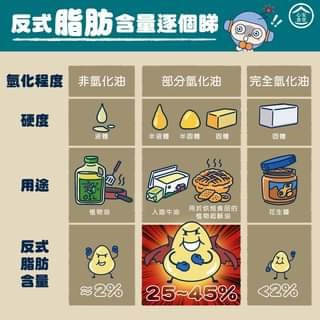
This poses a question: How can we get rid of PHOs and IP-TFAs in our diet? In this article, we will explain terms relating to PHOs and show consumers and traders how to identify PHO-free food products.
PHOs: Root of IP-TFAs
For food products made with vegetable oils, the use of hydrogenated vegetable oils will change the texture, stability and shelf life of the final product. Incomplete hydrogenation of oils will produce semi-solid or solid PHOs, whereas complete hydrogenation will result in fully hydrogenated oils that are waxy at room temperature. The former process can lead to large amounts of IP-TFAs, ranging from 25% to 45% of the total fatty acids.
Code One: PHOs can hide in many foods. To avoid manufacturing food products containing PHOs, traders can ask suppliers to provide PHO-free ingredients or use the healthier alternatives recommended by the World Health Organization (WHO).
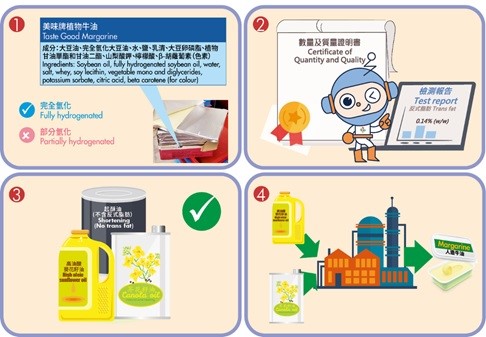
Figure: Traders can identify PHOs in food products by (1) reading the ingredient list or (2) obtaining product specifications and replacing PHO ingredients with healthier alternatives, such as (3) using oils high in unsaturated fats and (4) procuring specific fats and oils prepared by industrial processes other than hydrogenation.
How to Avoid PHOs or IP-TFAs? Read the TFA Level
TFAs are unsaturated fatty acids consisting of at least one trans double bond. Most TFAs (can be up to about 45% of a product's fat content) are synthetic fats used for manufacturing food products. They are known as IP-TFAs. TFAs can doubly jeopardise our heart’s health by lowering the “good” cholesterol level and raising the “bad” cholesterol level in our blood, thus increasing the risk of coronary heart diseases.
Code Two: If the nutrition label of a food product shows a high level of TFAs in total fat, it is likely that IP-TFAs or PHOs are added to the product (especially for food products made with vegetable oils). To avoid consuming food with ingredients containing PHOs, we should choose or procure food products with low or no TFAs.
Healthier Alternatives Are Around the Corner
Food manufacturers use oils and fats for different purposes. Apart from serving as a heat transfer medium, a release agent, a lubricant and a moisture barrier, oils and fats can be used to create body and texture of food for better mouthfeel and meltability, to bring out and release food flavours, and for oil binding, creaming and lamination. After ascertaining the functions and sources of fats and oils in food products, traders can replace the ingredients containing PHOs by making reference to the “Guidance to Replace Industrially-produced Trans Fats in Food”.
The healthier alternatives shall have the lowest saturated fats and the highest unsaturated fats. Their saturated fats should also be less than the sum of saturated fats and trans fats in the original PHO-containing products. If fats are only used as a heat transfer medium, a release agent or a lubricant (e.g. for frying), choose liquid oils that do not oxidise quickly, such as high oleic canola oil. If a food product needs saturated fats to bring out the body of food or serve other functions, it is advisable to combine different technologies (e.g. blending) for food formulation.
Code Three: PHOs are not produced by local manufacturers of fats and oils as they require specific industrial processes. Many oil importers and traders in catering and baking industries have been importing PHO-free ingredients for manufacturing food products. If product reformulation is required, traders can check the ingredient details of food products with suppliers as deemed necessary.
PHOs can be eliminated from our diet with tripartite efforts of consumers, the food trade and the Government. While consumers can choose food products low in TFAs, manufacturers can replace PHOs in food with other ingredients or reformulate their products. To effectively eliminate the presence of PHOs from the source of the food supply chain, the Government proposes to amend the Harmful Substances in Food Regulations (Cap. 132AF) by listing PHOs as prohibited substances in food and stipulating the labelling requirements for hydrogenated oils. The three-month public consultation on the proposed amendments was concluded on 15 March 2021. We would like to thank different sectors for their valuable opinions provided during the consultation period.
Dining Out
Love It or Loathe It: Poon Choi and Its Microbiological Risks
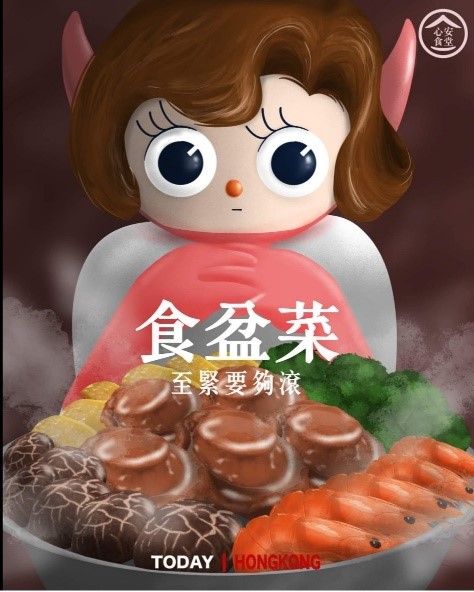
Dining out has become less popular. More people have turned to online ordering and door-to-door food delivery services. Local eateries ranging from fine-dining restaurants to fast food chain stores, large or small, have jumped on the bandwagon to offer takeaway poon choi for customers to enjoy a feast at home without going to a restaurant. However, there are occasionally food poisoning outbreaks reported to be associated with this local delicacy.
A Case Study
About two weeks before the 2021 Lunar New Year, one suspected food poisoning case relating to poon choi was reported. Ten persons were affected after consuming a takeaway poon choi and other hot dishes purchased from a licensed eatery in Hung Hom. The suspected causative agent was Salmonella species. Although the licensed restaurant has been in operation for more than a decade, it only started selling poon choi in December 2020.
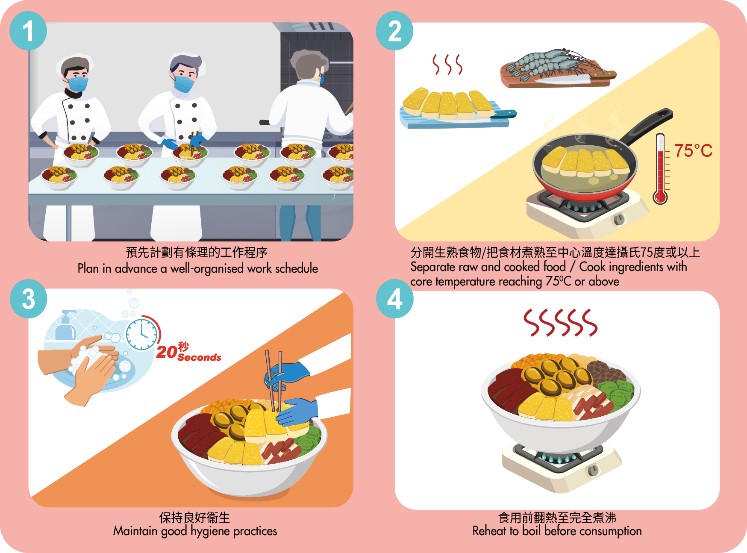
Site investigation revealed that the same pair of chopsticks was used by food handlers both for beating raw eggs and transferring cooked food ingredients to the poon choi, and there was no further heat treatment in the preparation of the dish. Moreover, the food handlers had to deal with cooked food and raw food at the same time, but they could not always maintain proper hand hygiene as no liquid soap was available beside the wash basin in the food preparation room. Cross-contamination of chicken in the poon choi by food handlers and utensils, and insufficient reheating of the poon choi by the victims before consumption, are the factors contributing to the food poisoning outbreaks.
Why Is Poon Choi a High-risk Food?
Poon choi contains various kinds of food ingredients which are susceptible to contamination if not properly handled. A sudden increase in orders during festive occasions will also cause problems in poon choi preparation. While an understaffed kitchen certainly puts food safety in jeopardy, hiring temporary food handlers may not help improve the situation if no adequate and proper training is provided.
Preparing a considerable amount of different food ingredients too far in advance, repeated handling of ingredients (like chopping of poached chicken) and prolonged storage of ingredients at room temperature before delivery or collection can all subject poon choi to risks of cross-contamination and bacterial growth. Inadequate reheating of poon choi before consumption, together with the points mentioned above, are the factors which make poon choi a high-risk dish.
Key Points to Note
- Poon choi is a high-risk food as the production process is complex, labour intensive and time consuming.
- Preparing different types of food in bulk within a short period of time, compounded with underequipped facilities and inadequate manpower, render poon choi more prone to cross-contamination.
- Thorough cooking and reheating of poon choi to a safe temperature is the key to food safety.
Advice to Consumers
- Purchase poon choi from reputable licensed suppliers.
- Reheat poon choi thoroughly until its core temperature reaches 75°C or above or bring it to a complete boil before consumption. The required reheating time increases with the size of poon choi. During reheating of poon choi, cover the container for thorough heating of all ingredients.
- Consume poon choi as soon as possible once it is received, and finish the reheated poon choi in one go.
Healthy Eating Basics and Smart Food Choices
1. Rate Your Drinks: Instant Sugary Drinks
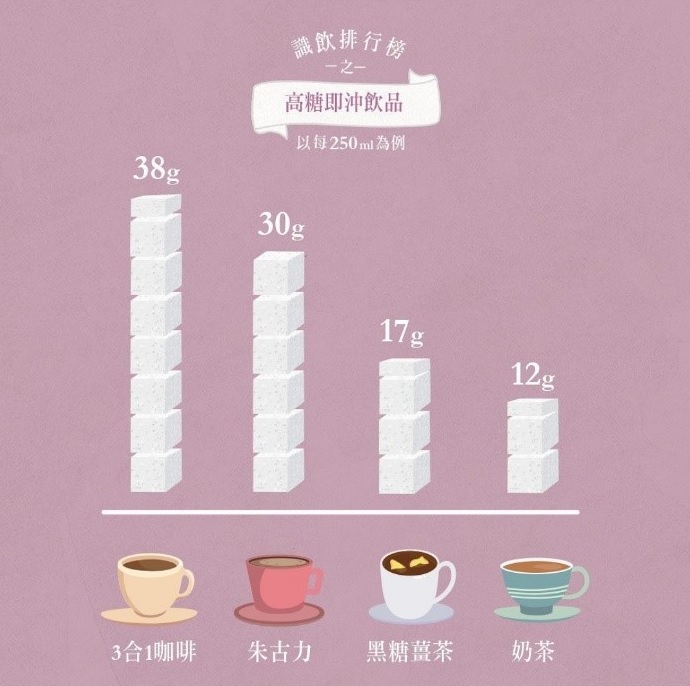
We sometimes have an instant hot drink as an easy way to get warm when the weather is cool. While these drinks provide convenience, they are also laden with sugar. For a serving size of 250ml (one cup) of brown sugar ginger tea and hot chocolate, there are 17g and 30g of sugar respectively. A cup of 3-in-1 coffee even contains 38g of sugar, which is three quarters of the maximum recommended daily sugar intake for adults! For a healthy hot drink, you may try herbal teas with no added sugar. They can nourish your skin and are beneficial to health.
2. A Healthy Dish to Go with Rice — Braised Pork Chop in Onion Sauce
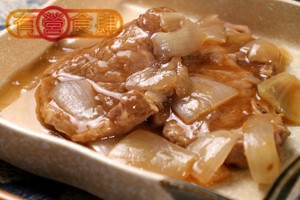
Steamed minced pork patty and steamed eggs are some usual dishes to go with rice, but you would not like to taste them if you eat them too often. Here we would like to show you how to prepare a home style dish “braised pork chop in onion sauce”. It is not only healthy and delicious but also a good match for rice. The sauce is prepared with a lot of onions and is as rich in flavour as ready-to-use black pepper sauce, but it is less salty and carries the sweetness of braised onions. The dish is easy to make and suitable for kids and adults. Interested readers can give it a try. The recipe can be found on the “EatSmart@restaurant.hk” website of the Department of Health (https://restaurant.eatsmart.gov.hk/eng/content.aspx?content_id=234).
News on CFS
(1) Wash Vegetables Properly to Remove Residues Without Losing Nutrients
Vegetables and fruits should be washed before consumption, but there are different views as to how to wash them thoroughly without losing the nutrients. For this reason, the CFS has prepared a short video “Washing Vegetables & Fruits” to show the correct ways of washing vegetables and fruits. The video is a light-hearted parody of some familiar movie scenes. You are welcome to watch the video by clicking the following link or scanning the QR code on the right.
https://www.youtube.com/watch?v=y9SqcqCzLNQ

(2) 5 Keys to Food Safety — Window Stickers
The WHO has put forward the “5 Keys to Food Safety” for everyone to follow as simple and effective ways to prevent foodborne diseases:
- Choose (Choose safe raw materials)
- Clean (Keep hands and utensils clean)
- Separate (Separate raw and cooked food)
- Cook (Cook thoroughly)
- Safe Temperature (Keep food at safe temperature)
To facilitate people to make food choices having regard to their health conditions, especially in selecting ready-to-eat food products with raw or undercooked food/ingredients, the CFS has produced two new window stickers for display at restaurants to remind customers to pay attention to food safety.
1. Raw or undercooked food
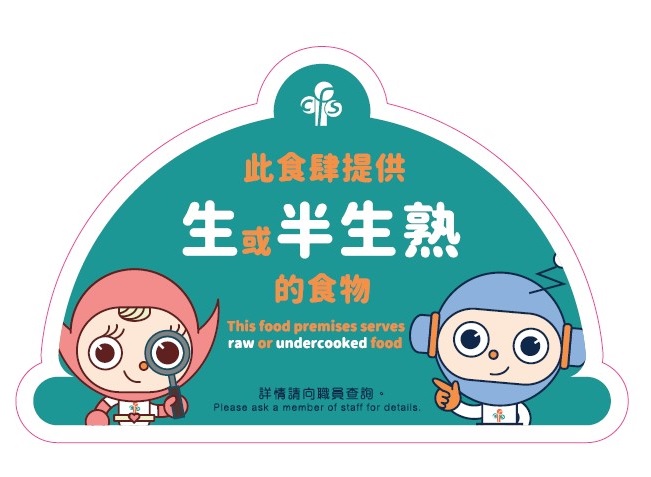
The public should note that consumption of raw or undercooked food bears inherent risks of food safety, as the risk of foodborne diseases will increase, especially among pregnant women, infants and young children, the elderly and people with weakened immunity. In light of this, restaurant owners have the obligation to provide accurate food labelling for consumers to make informed food choices.
2. Beef burgers should be fully cooked for food safety
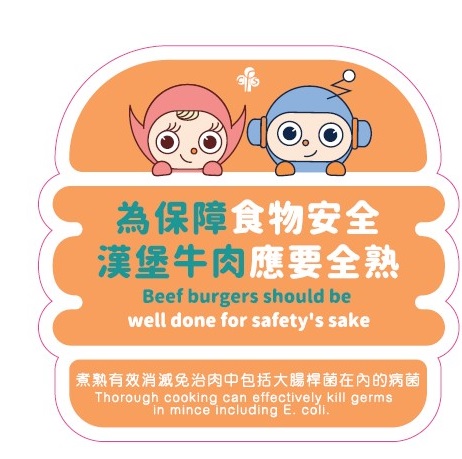
Burger steaks should always be cooked till well done regardless of the quality, source and price of the meat. When meat is minced to produce burger steaks, harmful bacteria such as Salmonella or pathogenic Escherichia coli (E. coli) on the meat surface will spread throughout the patty. Unless a burger steak is fully cooked, these bacteria in it can remain alive. Therefore, ground beef should be cooked until the internal temperature reaches at least 75°C or until browned throughout with the juice running clear. Likewise, burger patties and other ground meat products should be thoroughly cooked to an internal temperature of at least 75°C before being served.
(3) Nutrition Labelling Scheme
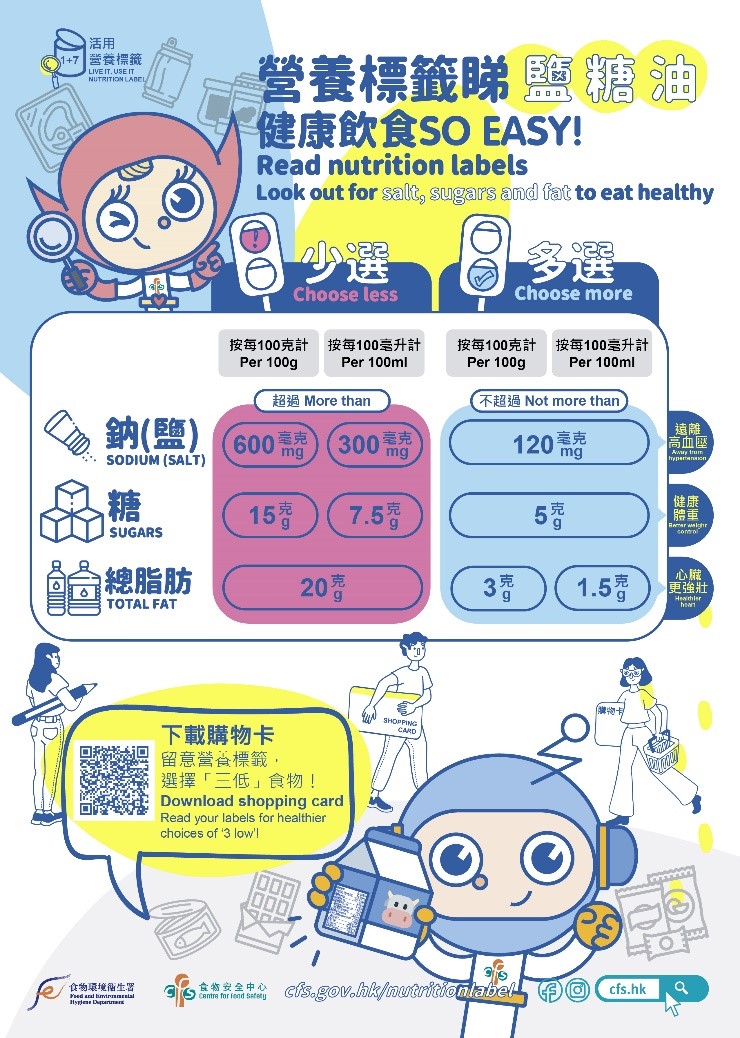
The Nutrition Labelling Scheme, which came into effect in July 2010, covers nutrition labelling and nutrition claims for prepackaged foods with a view to assisting consumers in making smart food choices. The CFS has produced a set of shopping guide cards with definitions of high, medium and low total fat/sugars/sodium content as a tool for consumers to choose heathier foods. Please visit the following website for details:
https://www.cfs.gov.hk/english/whatsnew/whatsnew_act/whatsnew_act_19_Nutrition_Labelling_Scheme.html

(4) Membership Recruitment of Consumer Liaison Group for the New Term (2021-2024)
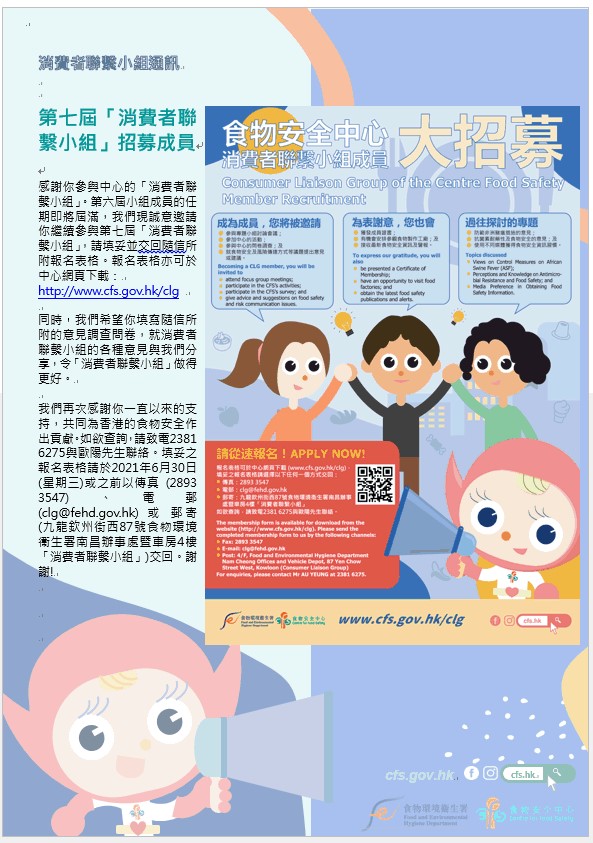
The Consumer Liaison Group (CLG) of the CFS was established in August 2006. It provides a platform for better communication with the public on various food safety issues and collection of suggestions and comments from them. Through activities and focus group meetings, the CLG seeks to gain an understanding of public knowledge, beliefs and risk perceptions of food safety for developing effective risk communication strategies and messages to meet the needs of the public.
As a CLG member, you will be invited to:
- attend focus group meetings;
- take part in activities organised by the CFS;
- participate in surveys conducted by the CFS; and
- give advice and suggestions on food safety and risk communication issues.
To express our gratitude, you will:
- be presented with a certificate of membership;
- have the opportunity to visit food factories; and
- receive the latest food safety publications and alerts.
Please take this chance to join the CLG and exchange views with us. The membership application form can be downloaded from the CFS website.
(5) CFS' Talks Held during Lifestyle ShoppingFest 2021
The HKTDC Lifestyle ShoppingFest 2021 was held earlier at the Hong Kong Convention and Exhibition Centre. Taking this opportunity, the CFS organised two talks on “Nutrition Label 1+7: an Easier Way to a Healthier Diet” on 29 and 30 April 2021 in conjunction with the event as part of the activities of the “Wholesome April” campaign. During the talks, quizzes were conducted to enhance familiarity with the nutrition label for the public to make healthy dietary choices. The participants received souvenirs themed on the mascot characters of the CFS. An extra prize was awarded to those who answered the questions correctly.
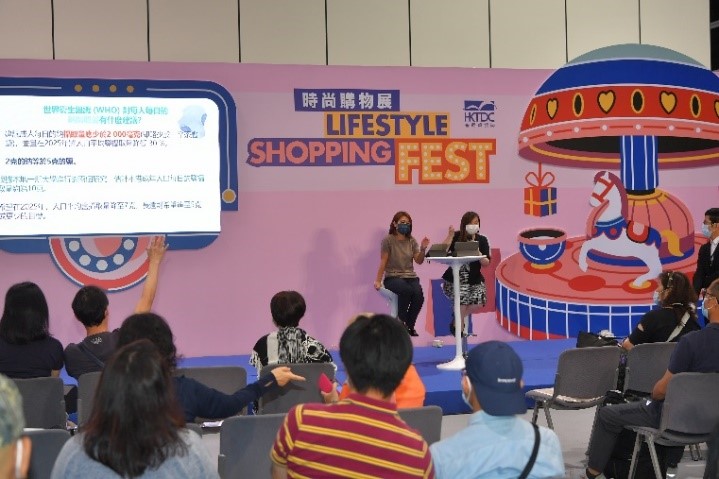
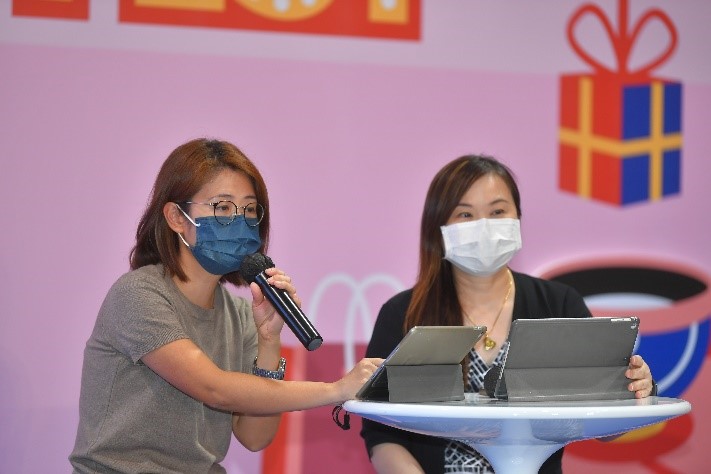
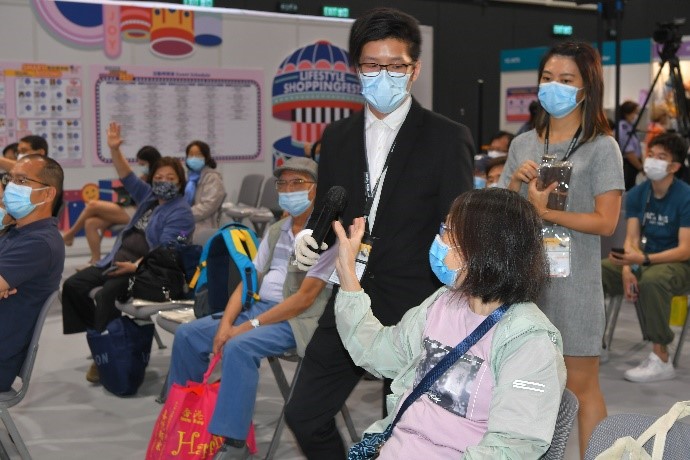
Ask Our Mascots
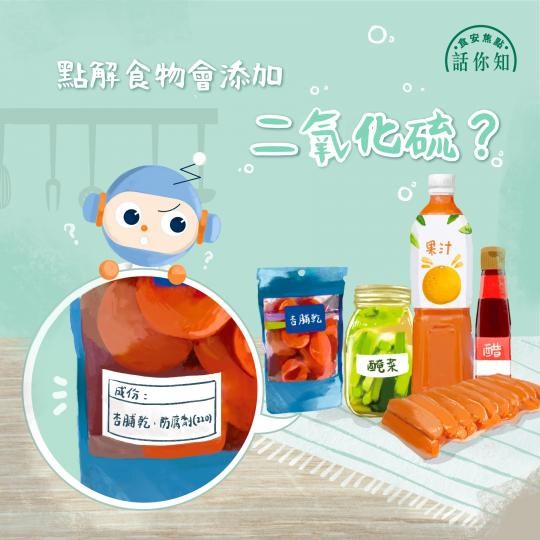
Why Is Sulphur Dioxide Added to Food?
Mandy: Mascot ON, I sometimes notice that there are strange chemical names or numbers and the word “preservative” next to them on the ingredient list of prepackaged foods. What do they mean?
ON: If prepackaged foods are added with preservatives, the preservatives used have to be specified in the ingredient list. For example, you may see the word “preservative” followed by the number “220” in a bracket. Actually, “220” is the identification number of sulphur dioxide, or SO2. That is to say, SO2 is used as a preservative in the prepackaged food product concerned.
SO2 is a versatile food additive. It can act as a preservative to inhibit the growth of microbes and extend the shelf life of food products. It is also an antioxidant that prevents browning associated with oxidation in food and helps maintain the appearance and colour of food products. That's why SO2 is added to many food products, including dried fruits, pickled vegetables and beverages like fruit juices.
Mandy: Is it harmful to consume such foods and drinks?
ON: SO2 has a long history of use in food production. Like other food additives, it has gone through rigorous assessments by international food safety authorities before it is ascertained as safe for food use. If SO2 is added to food products in accordance with the Good Manufacturing Practice, the products should be safe upon normal consumption. However, some people are hypersensitive to SO2. They may experience allergic symptoms such as breathing difficulties, headache and nausea after consumption of food added with SO2.
Mandy: Is there any legislation governing food additives?
ON: In Hong Kong, there are legislative requirements on the use of food additives as well as their labelling on food packaging. If SO2 is added to prepackaged foods, its functional class as a preservative, and the specific name “sulphur dioxide”, or “220”, its identification number under the International Numbering System, must be stated in the ingredient list. In addition, for prepackaged food product containing sulphite in a concentration of 10 parts per million or more, the name of the sulphite and its functional class must be specified in the ingredient list for identification by consumers.
Food Safety Quiz
- is more common in winter and can cause large-scale food poisoning outbreaks. (See“Feature Article”.)
- In comparison with most bacteria, Norovirus is relatively and may remain infectious in food heated to 60°C for 30 minutes. (See“Feature Article“.)
- are also notorious for being the main culprit of industrially-produced trans fats that cause harm to heart health. (See“Mascot ON in Lesson“. )
- is usually found in rotten apples. We must store apples properly to prevent mould growth on them. (See“Diary of Mascot ON“.)
- is a versatile food additive. It can act as a preservative to inhibit the growth of microbes and extend the shelf life of food products. (See“Ask Our Mascots“.)
- Answers:
- Norovirus infection
- heat resistant
- Partially hydrogenated oils
- Patulin
- Sulphur dioxide
Diary of Mascot ON
ON's Case File – Who Contaminated the Apples?
#Mascot MUI: What's the matter? Why does everyone look so nervous?
#Mascot ON: They've all got an apple in their hands. Is it something to do with apples? I must find out the truth.
The mystery is solved! The truth is contamination of apples, and the major contaminant is pautlin. Patulin is a mycotoxin produced by a variety of moulds such as penicillium and aspergillus. It may occur in damaged or mouldy fruits, especially apples. Ingesting high doses of patulin can cause nausea, gastrointestinal disturbance and vomiting in humans.
Patulin is usually found in rotten apples. We must store apples properly to prevent mould growing on them. Don't eat mouldy or damaged apples, or use them to make juice. Even if we've cleaned the surface or cut off the mouldy and damaged parts of an apple, patulin may have diffused into its other parts. It's not easy to ensure that we've removed all the patulin present in the fruit before pressing.
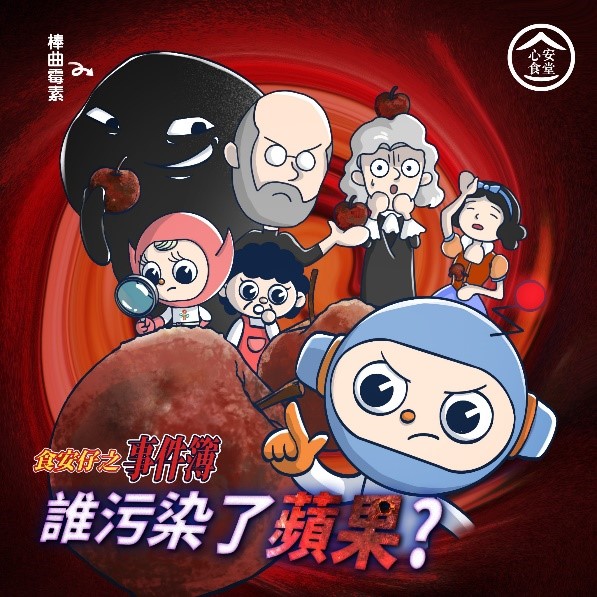
Subscription
Members of the public are welcome to visit the CFS website (www.cfs.gov.hk) for the online version of the Food Safety Bulletin. Printed copies (Chinese version only) can be obtained from the Communication Resource Unit (CRU) of the CFS. For enquiries, please call 2381 6096.
Communication Resource Unit Exhibition Centre Open to Visitors
The CRU Exhibition Centre is located near Exit C of the MTR Nam Cheong Station. It accommodates an exhibition hall with public and trade information corners equipped with audiovisual facilities for visitors to gain first-hand experience about food safety in Hong Kong. Members of the public and the trade are welcome to visit the exhibition hall free of charge.
(Under the epidemic situation, the Exhibition Centre may not be open to the public due to social distancing measures. Please visit the CFS website (www.cfs.gov.hk) for the latest opening hours of the Exhibition Centre.)
|
Address: |
Room 401, 4/F, Food and Environmental Hygiene Department Nam Cheong Offices and Vehicle Depot, 87 Yen Chow Street West, Sham Shui Po, Kowloon |
|
Enquiries: |
2381 6096 |
|
Email: |
|
|
Opening hours: |
Monday to Friday: 8:45 a.m. to 1:00 p.m.; 2:00 p.m. to 5:30 p.m. Closed on Saturdays, Sundays and public holidays |